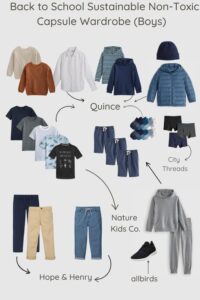Uncategorized
How to Introduce Kids to Sustainable Fashion Choices
Teaching kids about sustainable fashion is an excellent way to instill values of environmental responsibility, mindful consumption, and appreciation for quality over quantity. While kids might not fully grasp the concept of sustainability, engaging them through fun, relatable, and age-appropriate methods can make a lasting impact. By introducing sustainable fashion choices early on, parents can help their children develop habits that benefit the planet and encourage thoughtful decision-making.
Here’s how to introduce kids to sustainable fashion in an enjoyable and impactful way.
1. Explain Sustainability in Simple Terms
Kids are naturally curious, so start by explaining sustainability in a way they can understand.
- Keep It Relatable: Use examples from their everyday lives, like reusing toys or recycling. Explain that sustainable fashion means choosing clothes that are good for the planet and made without harming people or animals.
- Tell Stories: Share fun facts or stories about how their clothes are made. For example, “This shirt is made from recycled plastic bottles!”
- Use Visual Aids: Videos, pictures, or books about sustainability can make the concept more engaging for younger kids.
Helping kids understand the “why” behind sustainable fashion builds a foundation for mindful choices.
2. Involve Kids in Shopping Decisions

Empowering kids to participate in sustainable shopping teaches them to make thoughtful decisions.
- Look for Eco-Friendly Brands: Choose brands that use organic fabrics, recycled materials, or fair-trade practices. Explain these labels to your child.
- Set Shopping Rules: Encourage them to ask questions like, “Do I really need this?” or “Can I use this for a long time?”
- Teach Them About Quality: Show how high-quality clothes last longer and feel better, helping kids understand the value of buying fewer, better-made items.
Including kids in the process makes sustainable fashion a shared effort rather than just a rule to follow.
3. Make Secondhand Shopping an Adventure
Thrifting is a fun and budget-friendly way to introduce kids to sustainable fashion.
- Treasure Hunt: Frame secondhand shopping as a treasure hunt where they can find unique, one-of-a-kind pieces.
- Highlight Benefits: Explain that buying pre-loved clothes helps reduce waste and gives the items a new life.
- Visit Local Stores: Take them to thrift shops or consignment stores and let them pick their favorites.
Kids often enjoy the creativity and uniqueness of thrifting, making it a memorable and sustainable experience.
4. Encourage Upcycling and DIY Projects
Get creative with old or outgrown clothes by turning them into something new.
- Simple Crafts: Show kids how to add patches, paint designs, or embellish their clothes to give them a fresh look.
- Repurpose Clothes: Turn old t-shirts into tote bags or jeans into shorts.
- Personalized Style: Let kids customize their wardrobe, which not only promotes sustainability but also encourages self-expression.
Upcycling teaches kids the value of resourcefulness and adds a creative twist to sustainable fashion.
5. Teach the Importance of Caring for Clothes
Sustainability starts with making clothes last longer. Teaching kids proper care habits can reduce waste.
- Laundry Lessons: Show them how washing clothes in cold water saves energy and prevents wear.
- Repairing Basics: Teach simple skills like sewing a button or fixing small tears.
- Storage Tips: Explain how folding or hanging clothes properly keeps them in good condition.
Caring for clothes instills a sense of responsibility and appreciation for what they own.
6. Create a Capsule Wardrobe Together
A capsule wardrobe promotes minimalism and sustainability by focusing on versatile, quality pieces.
- Plan Together: Involve your child in choosing a few essential items they love and can mix and match.
- Explain the Benefits: Talk about how fewer clothes mean less clutter and more time to enjoy their favorites.
- Focus on Timeless Pieces: Choose neutral colors and classic styles that work for different seasons and occasions.
Capsule wardrobes teach kids the value of intentional choices and help simplify their daily routines.
7. Talk About the People Behind the Clothes
Help kids connect with the human side of fashion to build empathy and awareness.
- Explain Fair Trade: Share how some brands ensure workers are paid fairly and work in safe conditions.
- Highlight Global Cultures: Introduce kids to traditional clothing from different countries, emphasizing craftsmanship and cultural significance.
- Use Examples: Show labels like “Made by hand” or “Fair Trade Certified” and explain what they mean.
Understanding the effort behind making clothes encourages kids to appreciate and respect the items they wear.
8. Celebrate Hand-Me-Downs
Hand-me-downs are a great way to promote sustainability while building a sense of family tradition.
- Make It Fun: Frame hand-me-downs as getting something special with a story or history.
- Personalize Them: Let kids add their own twist to hand-me-downs by accessorizing or customizing.
- Host a Swap Party: Organize a clothing swap with friends or family to make it a community event.
Hand-me-downs teach kids about sharing, reducing waste, and making the most of resources.
9. Limit Impulse Buys and Trends
Teach kids to think critically about their clothing choices, focusing on need rather than trends.
- Pause Before Buying: Encourage a “24-hour rule” where they wait before deciding on a purchase.
- Discuss Trends: Explain how fast-fashion trends are short-lived and often lead to waste.
- Celebrate Their Style: Reinforce that they don’t need to follow trends to look and feel great.
Helping kids avoid impulse buys fosters thoughtful consumption and reduces unnecessary purchases.
10. Be a Role Model
Kids learn best by example, so show them what sustainable fashion looks like in practice.
- Choose Quality Over Quantity: Let them see you prioritizing well-made, versatile pieces over fast-fashion trends.
- Reuse and Recycle: Demonstrate how you upcycle, thrift, or care for your wardrobe.
- Talk About Your Choices: Explain your decisions, like choosing eco-friendly brands or avoiding unnecessary purchases.
By modeling sustainable behavior, you inspire kids to follow suit and make mindful choices.
11. Highlight the Environmental Impact

Share age-appropriate facts about how sustainable fashion helps the planet.
- Water Usage: Explain how choosing eco-friendly materials saves water compared to conventional cotton.
- Waste Reduction: Talk about how landfills are filled with clothes that could have been reused or recycled.
- Carbon Footprint: Simplify the idea of emissions by discussing how buying local or secondhand helps the Earth.
Kids often respond positively when they see how their actions can make a difference.
12. Reward Sustainable Choices
Celebrate when your child makes a sustainable choice to reinforce positive habits.
- Praise Their Effort: Acknowledge when they pick quality over quantity or choose secondhand.
- Make It a Game: Challenge them to create outfits from their existing wardrobe without buying new items.
- Offer Incentives: Reward sustainable choices with experiences, like a crafting session, rather than material items.
Positive reinforcement makes the concept of sustainability enjoyable and engaging.
Conclusion
Introducing kids to sustainable fashion is an opportunity to teach them valuable life lessons about mindful consumption, responsibility, and creativity. By involving them in decisions, making it fun, and leading by example, parents can encourage habits that last a lifetime. Sustainable fashion isn’t just about clothes—it’s about shaping a generation that values quality, empathy, and care for the planet.
At Regal XX Hue, we’re committed to offering eco-friendly, stylish kids’ clothing that supports sustainability and individuality. Explore our collection today and start your journey toward a more sustainable wardrobe for your family!


